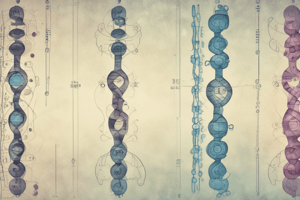Podcast
Questions and Answers
What are two types of chromosomal abnormalities mentioned in the text?
What are two types of chromosomal abnormalities mentioned in the text?
Numerical abnormalities and structural abnormalities
Explain the difference between trisomy 21 and Turner syndrome in terms of chromosomal abnormalities.
Explain the difference between trisomy 21 and Turner syndrome in terms of chromosomal abnormalities.
Trisomy 21 involves an extra copy of chromosome 21, while Turner syndrome involves a single X chromosome (45, X).
How are structural abnormalities of chromosomes detected?
How are structural abnormalities of chromosomes detected?
Through the normal banding pattern of a chromosome, providing a 'bar code' for mapping.
What advanced techniques are used in molecular cytogenetics to study chromosomes at the molecular level?
What advanced techniques are used in molecular cytogenetics to study chromosomes at the molecular level?
How do cytogeneticists use gene-specific probes in fluorescence in situ hybridization (FISH) experiments?
How do cytogeneticists use gene-specific probes in fluorescence in situ hybridization (FISH) experiments?
What has made cytogenetics an indispensable tool for the diagnosis of genetic disorders according to the text?
What has made cytogenetics an indispensable tool for the diagnosis of genetic disorders according to the text?
What is the main focus of cytogenetics?
What is the main focus of cytogenetics?
Describe the process of karyotyping.
Describe the process of karyotyping.
How many chromosomes are typically found in a normal human karyotype?
How many chromosomes are typically found in a normal human karyotype?
What is trisomy 21 and how is it detected?
What is trisomy 21 and how is it detected?
What are chromosomal abnormalities?
What are chromosomal abnormalities?
Name two techniques commonly used in cytogenetic analysis.
Name two techniques commonly used in cytogenetic analysis.
Flashcards
Karyotyping
Karyotyping
A technique to analyze chromosomes and determine genetic makeup.
Chromosome Abnormalities
Chromosome Abnormalities
Changes in chromosome number or structure, leading to genetic disorders.
Numerical Abnormalities
Numerical Abnormalities
Changes in the total number of chromosomes.
Structural Abnormalities
Structural Abnormalities
Signup and view all the flashcards
Trisomy 21
Trisomy 21
Signup and view all the flashcards
Molecular Cytogenetics
Molecular Cytogenetics
Signup and view all the flashcards
FISH (Fluorescence in situ Hybridization)
FISH (Fluorescence in situ Hybridization)
Signup and view all the flashcards
Comparative Genomic Hybridization (CGH)
Comparative Genomic Hybridization (CGH)
Signup and view all the flashcards
Normal human karyotype
Normal human karyotype
Signup and view all the flashcards
Aneuploidy
Aneuploidy
Signup and view all the flashcards
Autosomes
Autosomes
Signup and view all the flashcards
Down syndrome
Down syndrome
Signup and view all the flashcards
Study Notes
Cytogenetics: Karyotyping, Chromosomal Abnormalities, and Molecular Cytogenetics
Cytogenetics is a branch of genetics that focuses on the study of the structure and function of genetic material, particularly chromosomes. Techniques such as Fluorescent in situ Hybridization (FISH) and Comparative Genomic Hybridization (CGH) are commonly employed in cytogenetic analysis to determine any structural or chromosomal abnormalities.
Karyotyping
Karyotyping is a technique used to analyze the chromosomes of an individual in order to determine their genetic makeup. It involves the visualization of chromosomes in the metaphase stage of cell division, where the chromosomes are condensed and easily visible. The chromosomes are then arranged in a standardized format known as a karyotype, which allows for easy comparison and identification of any abnormalities.
A normal human karyotype contains 22 pairs of autosomes and one pair of sex chromosomes, resulting in a total of 46 chromosomes. Aneuploidies, or changes in chromosome number, can be easily detected on karyotypes. For example, trisomy 21, or Down syndrome, is a condition where an individual has three copies of chromosome 21, which can be detected through karyotyping.
Chromosomal Abnormalities
Chromosomal abnormalities refer to changes in the number or structure of chromosomes, which can result in various genetic disorders. These abnormalities can be categorized as numerical or structural.
- Numerical Abnormalities: These involve changes in the number of chromosomes, such as trisomy 21 (Down syndrome) and Turner syndrome (45, X).
- Structural Abnormalities: These involve changes in the structure of chromosomes, such as deletions, duplications, and translocations, which can be detected through the normal banding pattern of a chromosome, providing a "bar code" for mapping structural abnormalities.
Molecular Cytogenetics
Molecular cytogenetics is a subfield of cytogenetics that uses advanced techniques to study chromosomes at the molecular level. This includes the use of fluorescence in situ hybridization (FISH) and comparative genomic hybridization (CGH) to analyze small quantitative differences, such as copy number variations (CNVs).
In FISH procedures, labeled DNA or RNA probes are hybridized with their complementary target DNA sequences on chromosomes, generating colorful results. Gene-specific probes can also be used in the same experiment to positively identify the genes affected by chromosomal mutations. Cytogeneticists can then use coordinates on these rough chromosome maps to identify the positions of structural abnormalities.
Conclusion
Cytogenetics has evolved significantly over the decades, with the development of conventional banding techniques and the more recent use of molecular array comparative genomic hybridization. These advancements have made cytogenetics an indispensable tool for the diagnosis of various genetic disorders, paving the way for possible treatment and management.
Studying That Suits You
Use AI to generate personalized quizzes and flashcards to suit your learning preferences.
Description
Test your knowledge on cytogenetics, karyotyping techniques, chromosomal abnormalities, and molecular cytogenetics. Explore concepts such as numerical and structural abnormalities, and the use of techniques like FISH and CGH in cytogenetic analysis.




